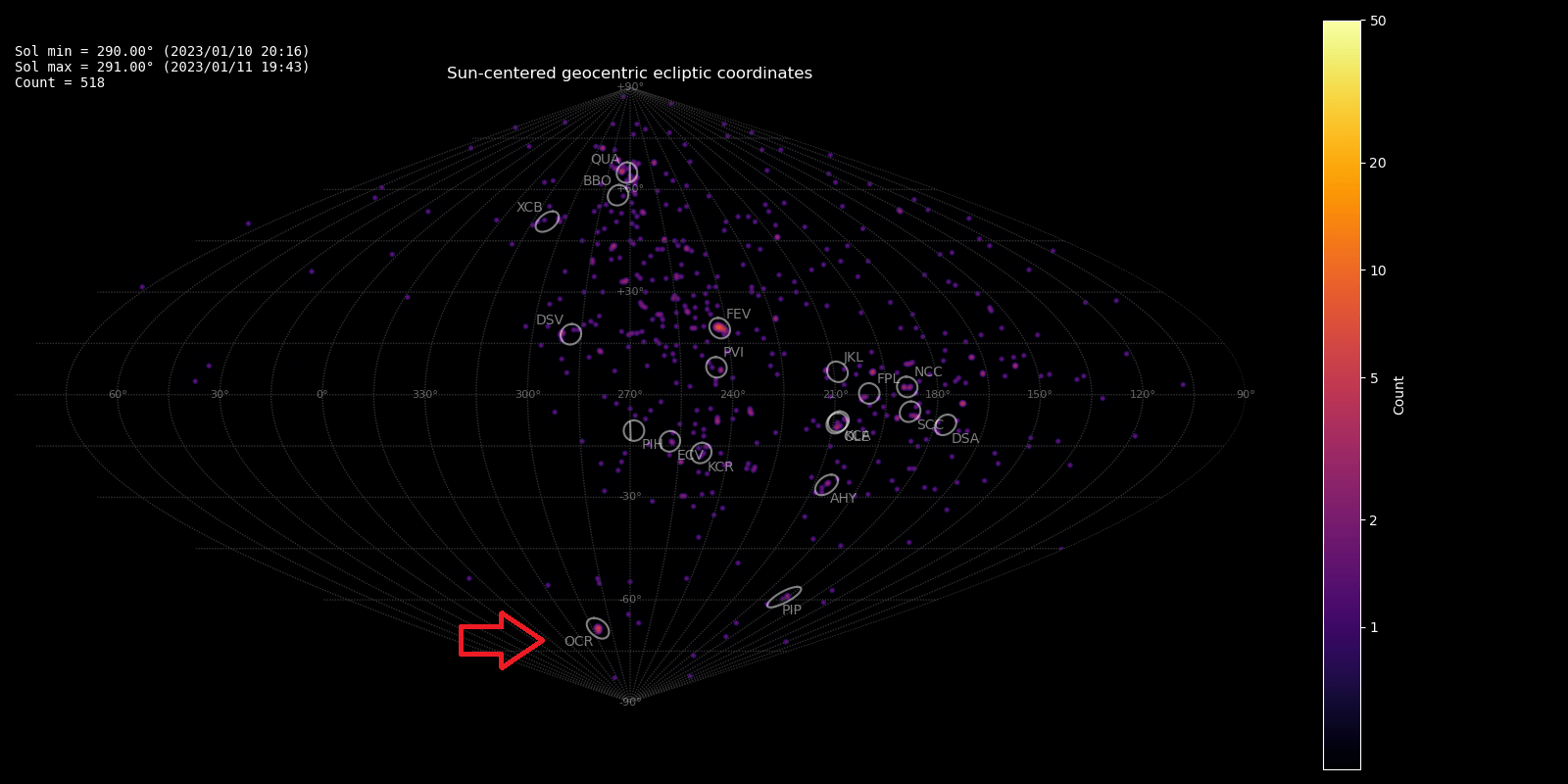By Damir Šegon, Denis Vida, Paul Roggemans, Jeff Wood, Mia Boothroyd, Ryan Fraser, Graeme Hanigan, Derek Poulton, Geoff Scott, James Scott and Christoph Zink
Abstract: Global Meteor Network cameras in Australia and New Zealand confirm the unusual activity of the omega-Carinids in 2023, centered at λʘ = 290.79 ± 0.13° which is 11 hours later than the activity reported by CAMS. The geocentric radiant was determined as αg = 153.8 ± 1.6° and δg = –73.5 ± 0.6°, with a geocentric velocity vg = 40.9 ± 0.5 km/s. With a Tisserand relative to Jupiter of ~0.7 the omega-Carinid meteoroid stream has a long-period comet type orbit with unknown parent body.
Introduction
Peter Jenniskens (2023) announced the detection of unusual activity displayed by the omega-Carinids (OCR#1033) during a short time interval 2023, January 10, 2h to 8h UTC by the CAMS Chile network. Eleven meteors were triangulated during the interval 289.22° < λʘ < 289.48°, centered on λʘ = 289.35 ± 0.03° (equinox J2000.0).
The omega-Carinid meteoroid stream has a long-period comet type orbit with unknown parent body. The median values for the 2023 orbit according to CAMS are:
- q= 0.958 ± 0.001 AU
- e = 0.986 ± 0.062
- i = 66.9 ± 0.7°
- ω = 341.3 ± 0.7°
- Ω = 109.35 ± 0.03°


Figure 1 – Omega-Carinid recorded at 2023 January 11, 16h47m29s UTC on AU000H with a 16mm lens (top) and on AU0007 with a 4mm lens (bottom). (Credit Perth Observatory).
Global Meteor Network results
The GMN cameras also picked up the sudden activity of the omega-Carinids in Australia and New Zealand, with a remarkable concentration of 5 very similar orbits in the time interval 290.63° < λʘ < 290.96° or 2023, January 11, between 11h and 19h UTC, centered on λʘ = 290.79 ± 0.13°, almost half a day later than the activity given for the CAMS network. The explanation for this difference is probably due to the fact that GMN has better coverage in Australia and New Zealand than in South-America. The preliminary shower identification of GMN identified 8 meteors as OCR#1033. Using D-criteria confirm all of these to belong to this shower with the earliest detected at λʘ = 287.35° and the last one detected at λʘ = 291.96°. However, to compute the most relevant mean orbit, the selection was limited to the concentration of 5 very similar orbits mentioned above.

Figure 1 – Radiant plot of the Global Meteor Network for 2023 January 10–11 in Sun-centered geocentric ecliptic coordinates.
The following mean radiant and orbit data has been calculated and is in excellent agreement with the CAMS result. The orbit has been reported and listed in the Working List of Meteor Showers of the IAU Meteor Data Center:
- λʘ= 290.79 ± 0.13°
- αg= 153.8 ± 1.6°
- δg= –73.5 ± 0.6°
- λg– λʘ = 295.4 ± 1.5°
- βg= –68.3 ± 0.5°
- vg= 40.9 ± 0.5 km/s
- a= 46.9 ± 45.5 AU
- q= 0.959 ± 0.003 AU
- e= 0.959 ± 0.030
- i= 66.4 ± 0.7°
- ω= 341.7 ± 1.1°
- Ω= 110.8 ± 0.1°
- Tj= 0.71 ± 0.16

Figure 2 – The omega-Carinids radiant plot.
Search for previous occurrences
No omega-Carinids could be located in the previous years of GMN data (2019–2022). This is most likely because Southern hemisphere coverage by the Global Meteor Network was very limited until major extensions were deployed during 2022. No trace of this shower in EDMOND data (2006–2016) either for the obvious reason there was no coverage at the Southern hemisphere, same for the SonotaCo orbit dataset as the radiant is too far south for Japanese observers.
The only orbit dataset with earlier recorded OCR-orbits is the CAMS dataset with 5 possible orbits, 4 of which were recorded 2016 January 9, between 12h31m and 13h59m UTC by CAMS New Zealand. The mean values obtained for the 5 orbits from 2016 agree very well with the 2023 results, but note the larger uncertainties for the 2016 data:
- λʘ= 288.50 ± 0.38°
- αg= 159.3 ± 5.4°
- δg= –73.0 ± 1.3°
- λg– λʘ = 297.7 ± 2.6°
- βg= –68.7 ± 1.8°
- vg= 41.4 ± 1.4 km/s
- a= 41.1 AU
- q= 0.951 ± 0.007 AU
- e= 0.977 ± 0.069
- i= 67.8 ± 2.2°
- ω= 339.5 ± 2.5°
- Ω= 108.4 ± 0.4°
- Tj= 0.58 ± 0.15
A detailed search through 19th and 20th century Southern hemisphere meteor data revealed no trace of any previously observed omega-Carinids in visual and other meteor observing reports.
Conclusion
Evidence was found for some unusual activity in 2023 of the poorly known long-period comet type meteoroid stream registered in the Working List of Meteor Showers of the IAU Meteor Data Center as omega-Carinids (OCR#1033). The short activity duration and the fact that the coverage of the Southern hemisphere could easily have missed any activity of this very southern radiant in past years may explain why the shower has been only detected in 2016 and 2023.
Acknowledgment
The authors thank all the camera operators and people involved in the Global Meteor Network. The Global Meteor Network (GMN) data are released under the following license: https://creativecommons.org/licenses/by/4.0/.
Reference
Jenniskens P. (2023). “Omega Carinid meteor shower 2023”. CBAT 5207, Daniel W. E. Green, editor.




